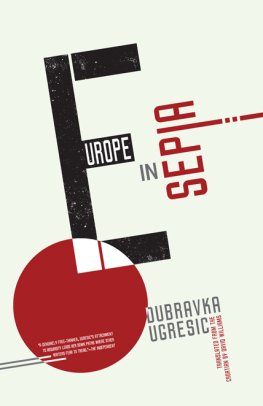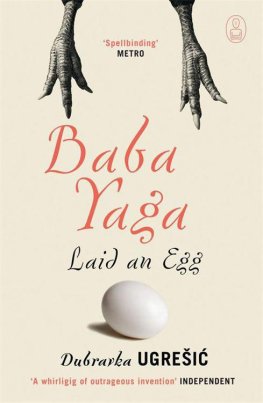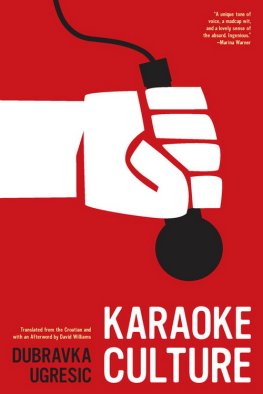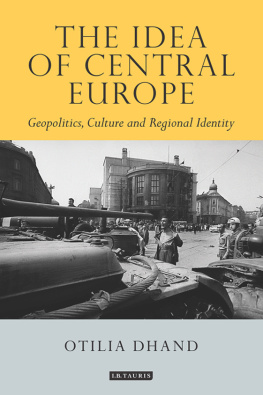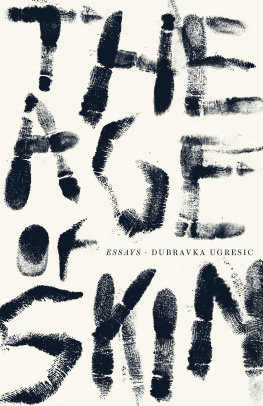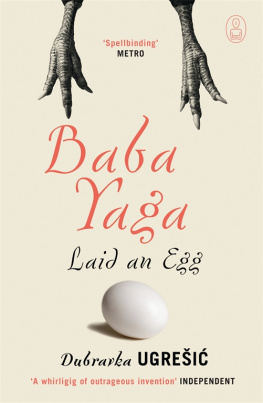Dubravka Ugresic
Europe in Sepia
We are a breed of men that has reached its upper limit, he would say, banging his mug on the marble like a hoof.
Yuri Olesha, Envy
NEW YORK, ZUCCOTTI PARK
I visited New York in October 2011, and a couple of days after arriving, I set off for Wall Street, not having checked the exact location of Zuccotti Park. Coming out of the subway, I fortunately spotted an information kiosk.
Excuse me, wheres the, ah. . revolution? I asked goofily.
Just go straight on, its a few blocks away, replied a young guy, his face spreading into a smile. Buoyed by the smile, I got going. As the rhythm of my pulse quickened, I wondered whether a long dormant rebel virus was stirring in me. Rebel?! Well, yeah, when you line up a few historical and personal details, its fair to say that rebellion and I are well acquainted.
My parents conceived me around the time when Tito said his famous NO to Stalin. I came into the world in 1949, when the Soviet Union and its fraternity of member states had recently accused Yugoslavia of deviating from the path of Marxism and Leninism. The same year Tito was declared a traitor and Yugoslavia condemned to isolation. I was born on March 27. On the same date, albeit eight years previously, the slogan Better the grave than a slave, better war than the pact1 was born. It was one I adopted at a tender age, and in time I developed a form of behavior, which psychologists so adept at creating new terms would today classify as LAT (Low Authoritarianism Tolerance) syndrome. Its entirely possible that Titos famous NO to Stalin set me on my way as a budding naysayer. The opening line of The Internationale, Arise, damned of the Earth, makes my skin tingle; Bandiera Rossa makes me cry. While children in other countries flicked through The Teddy Bears Picnic, my picture book story of choice was about a young man named Danko.2 Brave Danko tears his heart from his chest, lighting the way for a cowering crowd trapped in a deep, dark forest, and leads them into a sunny clearing. Danko ends up dead, of course, alone and abandoned, what else. The part where some imbecile, having just crawled out of the darkness and into the light, steps on Dankos still beating heart took root in my imagination forever. An unproductive affinity for dreamers who use their hearts as batteries has followed me unfailingly ever since.
By the time I got to grade school, together with my classmates I sent letters of support to Patrice Lumumba, imprisoned somewhere in distant Congo. As a girl I pronounced the names Jawaharlal Nehru, Gamal Abdel Nasser, Kwame Nkrumah, and Sirimavo Bandaranaike, leaders of the Non-Aligned Movement, with the same ease that todays kids pronounce Rubeus Hagrid, Albus Dumbledore, and Alastor Mad-Eye Moody. Theres no mystery in it; I was twelve when the Non-Aligned Movement held its first conference in Belgrade. I protested against the war in Vietnam, even though I wasnt a hundred percent sure where Vietnam was. I spent my childhood sincere in the belief that everyone in the world black, yellow, white, whatever had the right to freedom and equality.
On the approach to Zuccotti Park I spent a moment checking my pulse. I wondered whether the slogan Power to the workers, peasants and honest intelligentsia hadnt done a number on me, and in this respect, whether my compatriots, those who twenty years ago accused me of being Yugonostalgic, might have had it right after all. At the time I publically opposed the hysteria of nationalism, when I should have realized that nationalism is a matter of profit, not feeling. I opposed the war, when I should have accepted the thesis that war is just business, a way to make money by other means. My compatriots cottoned on to these things from the outset, and unperturbed, ran roughshod over the top of me, reenacting what the aforementioned imbecile from my picture book did to Dankos beating heart. Drawing near to Zuccotti Park, I wondered whether that old revolutionary fervor had been hibernating in me, lying in wait for its chance to come out, now, at the wrong time, and in a place I would have least suspected.
YUGONOSTALGIA
I found myself back in America having accepted a kind invitation from Oberlin College in Ohio, where they had organized a lecture series entitled Remembering Communism: The Poetics and Politics of Nostalgia. The Oberlin invitation momentarily boosted my tattered, veterans self-confidence. It quickly atrophied. After twenty years of digging through the ruins, what more could I say about nostalgia, except from that, for me, it has long since lost its draw. The thought of getting down to work induced only fatigue. An insuperable mass of written and as-yet-unwritten texts swelled before me, my own and those of others. Then came the books, films, images, stories, memoirs, symbols and souvenirs, enough to fill an enormous storeroom, a chaotic archive in which all manner of things had settled: seminal theoretical texts such as Svetlana Boyms The Future of Nostalgia; popular films such as Wolfgang Beckers Goodbye Lenin; visual art projects such as the installations of Ilya Kabakov; the heap of random exhibits that had strayed their way in there.
But who gets to play supreme arbiter and rule on an exhibits belonging or non-belonging? The archive itself produces nostalgia only while it remains in chaos, while used as a storeroom, only while its existence remains illegal. The work of postcommunist and (in the Yugoslav case) postwar artists self-appointed archivists, collectors of ruins, doctors of nostalgia, archeologists of the everydayonly makes sense as a voluntary undertaking, and only when accompanied by the artists recognition of the futility of his or her work. As soon as the work achieves recognition, it immediately becomes susceptible to manipulation (although in itself worthless, nostalgia can still be a valuable commodity), and the energy that set it in motion vanishes. It is, parenthetically, in this disappearance that the fundamental paradox of any preoccupation with nostalgia resides: Nostalgia wipes its tracks, deceives its hunters, sabotages its researchers toil, never remaining what it is or was.
The Berlin Wall fell over twenty years ago. From todays perspective it is clear that it fell in an extremely unusual manner. Instead of imploding, or simply toppling left or right, the wall crashed down from a great height, like a meteor, sending concrete dust flying everywhere. Yugoslavia collapsed two years after the fall of the Berlin Wall, like a row of dominos, toppling from the north and west toward the east and south.
At the time I exchanged an invalid Yugoslav passport for a new Croatian one. Two years later, new passport in hand, I left the country, one that had only just realized its thousand-year dream of independence. And heres another paradox: the smaller the nation, the longer its history. Croatia declared both its independence and its (overnight) democracy, but the slogan I had adopted all those years agobetter the grave than a slavewas somehow triggered in me (my mistake, no doubt), and I quickly catapulted myself to Berlin.
The city had entered its fifth year of life A.W. (After the Wall). Pieces of the wall crunched beneath my feet, concrete dust particles shimmering on the backdrop of the deep blue Berlin sky, like a sea filled with billions of tiny plankton. I spent 1994 living in the old western part of the city, writing my novel The Museum of Unconditional Surrender. In yet another paradox, it was Berlin, not Zagreb, that served as a generator for reminiscence, as an ideal cutting desk for the montage of memories, a lens with perfect zoom and refraction, a pair of glasses custom-made for reading the Yugoslav and East European collapse.

